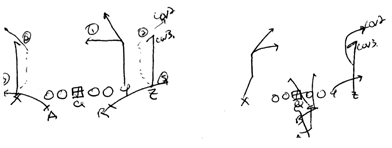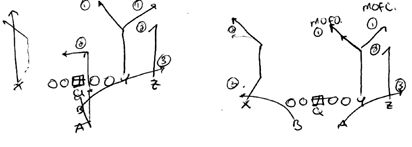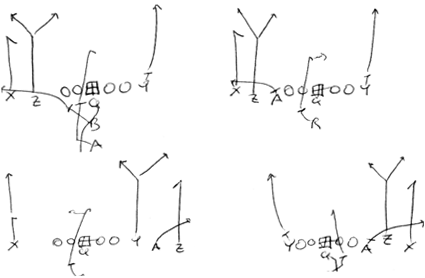Curl/Corner Read:

The infamous "curl/corner" read, shown above, has been around a long time. Currently, coaches like Charlie Weis, formerly with the Patriots and now with Notre Dame, Petrino at the University of Louisville, and Steve Spurrier have use this a lot. I already diagrammed some of the route's mechanics regarding Spurrier here.
Deep Choice:
An intriguing combination is the "deep choice" which combines a 3-level Cover 3 beater to one side with a Cover 2 beater by letting the slot or tight-end read MOFO/MOFC and run either a corner route or a post. The QB then adjusts his progression depending on MOFO or MOFC.

On the right is how Petrino at Louisville uses it, getting a corner/flat read against Cover 2, and on the left is how Weis likes to use it, instead getting a similar effect to the "Texas" concept used by many West Coast offense teams.
Choice Route:
If there is no deep middle safety, the "choice" receiver will plant at 10-12 and drive for the goal post, looking for the ball over his inside shoulder. If there is a deep middle safety, he will stick his inside foot at 10-12 and break for the corner at a depth of 22-25 yards. The outside receiver runs a curl at 12 yards.
Louisville Version:

The Louisville version is the simplest. If the middle of the field is closed (or there is 1-high) the QB will look for the corner first, then the curl, then to the flat to the strongside. The curl will look to slide a bit inside the first flat defender. Basically, if the cornerback retreats with the corner route, then the QB has a simple curl/flat read.
Against MOFO, the QB looks (1) to the deep post route, (2) to the corner route, and (3) to the flat (sometimes it is a hitch route). This is a basic hi/lo read, and he should be able to hit the post or the corner route for a significant gain.
The Weis version:

Against cover 3/MOFC, the route is read exactly the same (1-corner, 2-curl, 3-flat). Against MOFO it becomes like Texas, in that the QB is high/low'ing the Mike or middle linebacker rather than the outside cornerback. The QB looks for the post first: if the Mike squats or does not retreat fast enough, the QB must get it over his head and throw it to the post, splitting the safeties; if Mike drops fast (in the "Tampa 2" defense made popular by Tony Dungy, the Mike linebacker drops back so far and quickly he becomes like a deep middle safety) the QB wants to look for the RB over the middle on either a quick cross or an angle route, as shown above.
If Mike drops deep to cover the post but Sam (strongside outside linebacker) collapses on the RB, then the curl should be open late, as he slides into the QB's vision and the open space.
Conclusion:
While "reading on the fly" appears difficult to do, the routes shown above have only a key or two and have proven to be effective at many levels, including High School. The godfather of all "reading passing games" is of course the run and shoot (see link for details of its routes against different coverages), and while no major college or pro team uses it in its full form, these routes show its lasting impact and that much can be learned from its six or seven basic plays.



4 comments:
Chris,
Fantastic posts. Glad to see you back posting. What do you think about a dig route on the backside of the Weiss version? Versus two safeties you get a variation of the NCAA combination. Post-dig combos are our best stuff vs. Cover 4 anyway and it gives the Qb a quick 1-2-3 read. MOFO=post-dig- back.
good stuff, I see teams run a variation where the outside receiver runs a 7 step deeper hitch/shallow curl and the inside receiver runs a "seam read". vs. 2 deep he bends it between the safties, vs. single high saftey he has the option of breaking it off and finding an opening vs. zone or continuing on the seam based on the deep defender. vs. man he tries to beat the defender deep.
There is usually a shallow cross coming from the opposite side
Chris did you get these reads form watching tape or playbooks?
Spread22, A dig route could work well, or at least some kind of deeper curl. Big thing is vs. Cover 2 if Mike drops and takes the post but some of the other undercoverage squeezes the RB, something else should open up, likely a curl or in to either of the outside receivers. I also like your idea of turning it into an NCAA route combo. Could be the key! I just got a copy of the Dan Henning playbook and it appears he likes to use a corner route backside, probably just to draw the coverage away, but who knows. Sounds like it'd work.
anon: Combination of sources, as usual. Hard to pin down. Phone conversations, tapes, people I've spoken to, playbooks I get my hands on, each filtered through what I know about football and an attempt to present it in a coherent and helpful way. I try to present things in a broad enough fashion that many coaches could integrate them into their systems.
Nice post. I'd like to see another one on the running back route adjustments. You did one on Norm Chow's approach, but what seems forgotten is the Bill Walsh-installed hook / out route combination. Very effective against Will.
Post a Comment